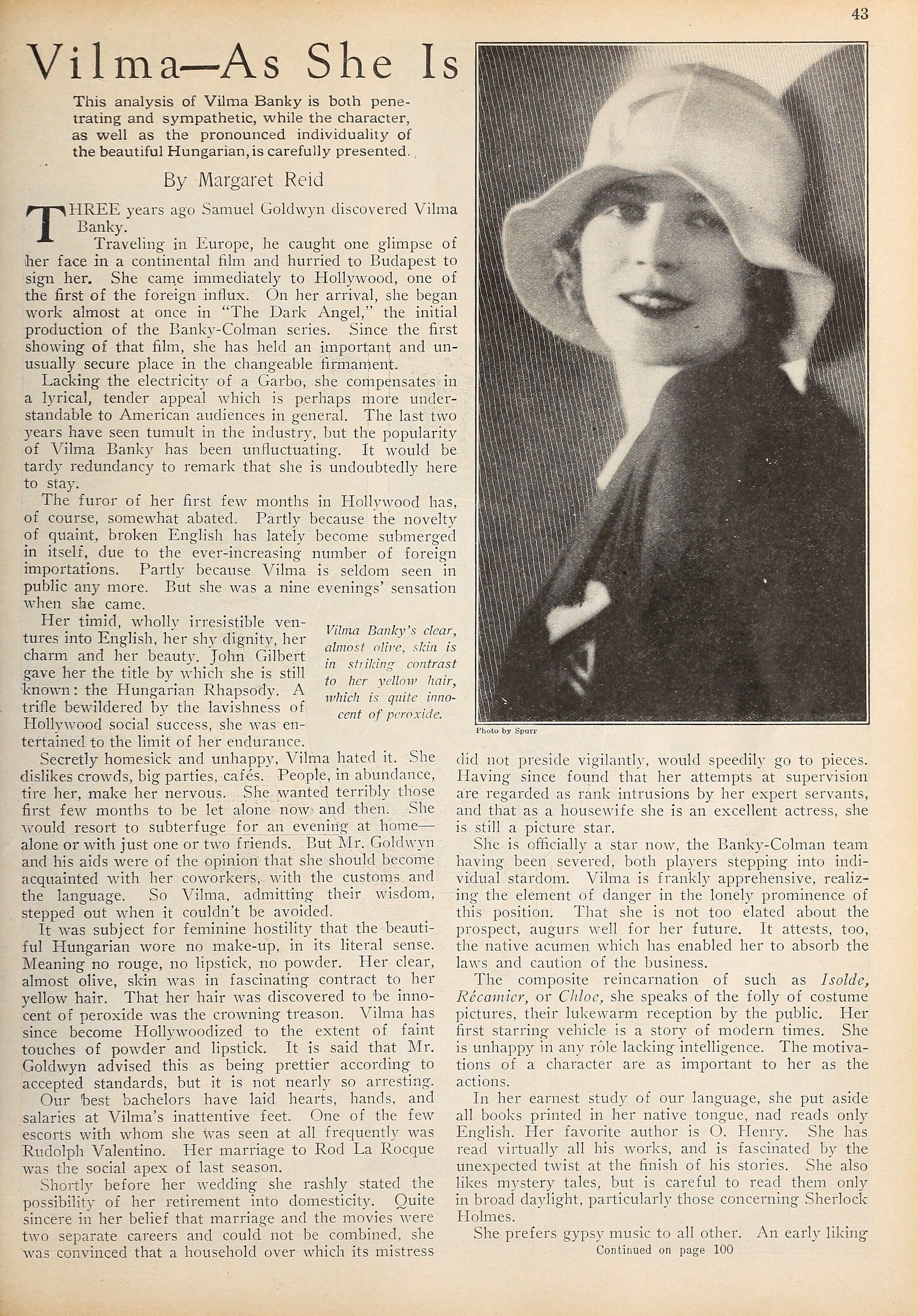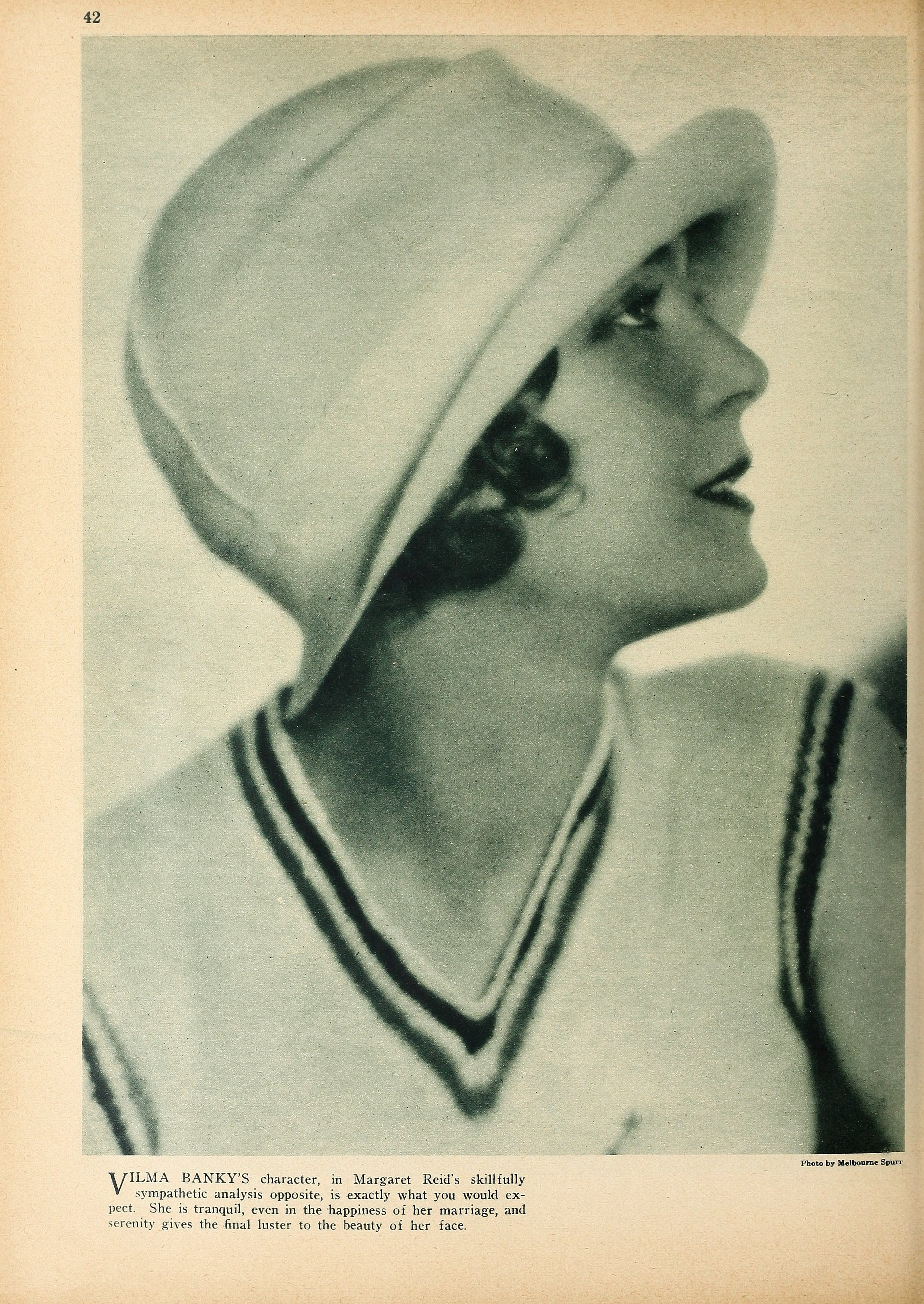Vilma Banky — As She Is (1928) 🇺🇸

Three years ago Samuel Goldwyn discovered Vilma Banky. Traveling in Europe, he caught one glimpse of her face in a continental film and hurried to Budapest to sign her. She came immediately to Hollywood, one of the first of the foreign influx.
by Margaret Reid
On her arrival, she began work almost at once in The Dark Angel, the initial production of the Banky-Colman series. Since the first showing of that film, she has held an important and unusually secure place in the changeable firmament.
Lacking the electricity of a Garbo, she compensates in a lyrical, tender appeal which is perhaps more understandable to American audiences in general. The last two years have seen tumult in the industry, but the popularity of Vilma Banky has been unfluctuating. It would be tardy redundancy to remark that she is undoubtedly here to stay.
The furor of her first few months in Hollywood has, of course, somewhat abated. Partly because the novelty of quaint, broken English has lately become submerged in itself, due to the ever-increasing number of foreign importations. Partly because Vilma is seldom seen in public any more. But she was a nine evenings’ sensation when she came.
Her timid, wholly irresistible ventures into English, her shy dignity, her charm and her beauty. John Gilbert gave her the title by which she is still known: the Hungarian Rhapsody. A trifle bewildered by the lavishness of Hollywood social success, she was entertained to the limit of her endurance.
Secretly homesick and unhappy, Vilma hated it. She dislikes crowds, big parties, cafes. People, in abundance, tire her, make her nervous. She wanted terribly those first few months to be let alone now and then. She would resort to subterfuge for an evening at home — alone or with just one or two friends. But Mr. Goldwyn and his aides were of the opinion that she should become acquainted with her co-workers, with the customs and the language. So Vilma, admitting their wisdom, stepped out when it couldn’t be avoided.
It was subject for feminine hostility that the beautiful Hungarian wore no make-up, in its literal sense. Meaning no rouge, no lipstick, no powder. Her clear, almost olive, skin was in fascinating contract to her yellow hair. That her hair was discovered to be innocent of peroxide was the crowning treason. Vilma has since become Hollywoodized to the extent of faint touches of powder and lipstick. It is said that Mr. Goldwyn advised this as being prettier according to accepted standards, but it is not nearly so arresting.
Our best bachelors have laid hearts, hands, and salaries at Vilma’s inattentive feet. One of the few escorts with whom she was seen at all frequently was Rudolph Valentino. Her marriage to Rod La Rocque was the social apex of last season.
Shortly before her wedding she rashly stated the possibility of her retirement into domesticity. Quite sincere in her belief that marriage and the movies were two separate careers and could not be combined, she was convinced that a household over which its mistress did not preside vigilantly, would speedily go to pieces. Having since found that her attempts at supervision are regarded as rank intrusions by her expert servants, and that as a housewife she is an excellent actress, she is still a picture star.
She is officially a star now, the Banky-Colman team having been severed, both players stepping into individual stardom. Vilma is frankly apprehensive, realizing the element of danger in the lonely prominence of this position. That she is not too elated about the prospect, augurs well for her future. It attests, too, the native acumen which has enabled her to absorb the laws and caution of the business.
The composite reincarnation of such as Isolde, Récamier, or Chloe, she speaks of the folly of costume pictures, their lukewarm reception by the public. Her first starring- vehicle is a story of modern times. She is unhappy in any role lacking intelligence. The motivations of a character are as important to her as the actions.
In her earnest study of our language, she put aside all books printed in her native tongue, and reads only English. Her favorite author is O. Henry. She has read virtually all his works, and is fascinated by the unexpected twist at the finish of his stories. She also likes mystery tales, but is careful to read them only in broad daylight, particularly those concerning Sherlock Holmes.
She prefers gypsy music to all other for Wagner was spoiled during her residence in Munich, where, all her friends being ardent devotees, it was incumbent on her to attend the Wagner concerts three times a week. She would love to be able to sing. In her head the tunes are perfect, but when she tries to give voice something happens to them.
Her English is still hesitant, and delightfully colored by her accent. She is, happily, slow to become standardized according to celluloid rule and rote. Her reserve, her imperturbable calm, have not yet given way to the more popular, insistent vivacity. She is aloof; it is to be sincerely hoped that the jealous accusations of “high-hat” will not frighten her into an assumption of jocular good-fellowship.
Admittedly she likes very few people. It is because, she supposes, she looks for too much in them. Above all, she abominates the poseur, the inflated ego, the artistic liar.
She is too unassuming to give her friendship unasked. She might admire a person tremendously, but she would not lower the barriers of her reserve, unless conscious of the other’s liking for her. It is this quality which will end her career at the proper moment, she says. When she finds that the public has lost interest — does not like her — she will leave the screen at once. There will be no hanging on, no trying to come back. She will definitely have finished, because it would be impossible for her to foist herself upon people who do not respond.
Vilma and her husband live in a quiet, Colonial house on a conservative street off the beaten track of show places. The street has an air of rich dignity, which is not lost on entering the La Rocque home. Their house is furnished in flawless taste, the luxurious grace of period furniture and decorations lending to it a European atmosphere.
She is essentially tranquil — in her success, her troubles, her worries, her happiness. Serenity gives the final luster to the beauty of her face.

Vilma Banky ‘s clear, almost olive, skin is in striking contrast to her yellow hair, which is quite innocent of peroxide.
Photo by: Melbourne Spurr (1888–1964)


Vilma Banky’s character, in Margaret Reid’s skillfully sympathetic analysis opposite, is exactly what you would expect. She is tranquil, even in the happiness of her marriage, and serenity gives the final luster to the beauty of her face.
Photo by: Melbourne Spurr (1888–1964)
Collection: Picture Play Magazine, July 1928
—
1928–04 — Norma Talmadge1928–05 — Corinne Griffith
1928–06 — Richard Dix
1928–07 — Vilma Bánky
1928–08 — Ramon Novarro
1928–12 — Greta Garbo
1929–01 — Norma Shearer
1929–02 — Evelyn Brent
1929–03 — Olga Baclanova
1929–04 — Ronald Colman
1929–05 — George O’Brien
1929–06 — Jack Mulhall
1929–07 — Esther Ralston
1929–08 — Adolphe Menjou
1929–10 — Nils Asther
1929–11 — William Powell
1929–12 — Renée Adorée
* 1930–03 — Gary Cooper
1930–04 — Willliam Boyd
1930–05 — Warner Baxter
1930–06 — Ruth Chatterton
* 1930–07 — Janet Gaynor
* 1930–08 — Joan Crawford
* 1930–09 — Laura La Plante
* 1930–10 — Billie Dove
